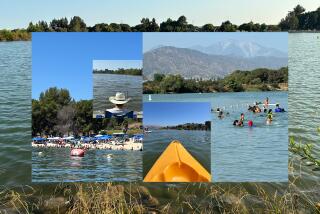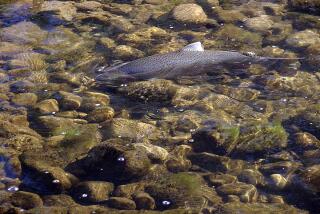Hooked on Snagging the Big One : Anglers trolling Lake Casitas for unpredictable bass admit they can get downright obsessive about their hobby.
- Share via
Whack, something’s on the line and it’s big--and Rod Thigpin jerks to attention. He’s up out of the seat at the front of his 17-foot bass boat and peering into the clear, green shallows of Lake Casitas. His graphite rod nearly folds over on itself as down in the weedy murk a crawdad is fractured between the jaws of a very large fish.
Largemouth bass are feisty eaters. Your typical largemouth--in the one- to two-pound range--writhes and contorts and slaps about while ingesting its meal. Largemouth have been known to explode from the water to snatch low-flying swallows. Slowed by bulbous bellies and the weight of their years, the behemoth largemouths, the lunkers of legend, feed differently, which is to say they simply chomp down and sit.
“It’s just like you’ve hooked on to a stump or something,” says Harry Jioras, an Ojai resident and retired fire captain who has dedicated much of his life to pursuing big bass. “It just won’t budge. When you hook into something like that, that’s when you get your rush.”
Ventura County and its surrounding environs are dotted with bass lakes, and a few of them contain some of the biggest largemouth bass anywhere on the globe. Many believe Lake Casitas is home to the monster bass, the piscine porker that will change a fisherman’s life and set the fishing world on its ear, a one in a billion fish that by dint of savvy and gluttony has grown into something approximating the shape and heft of a bowling ball.
Rod Thigpin, 27, is among these believers, and so he is experiencing a rush right now. The fish on the other end of his taut line is not the bass that will eclipse George Washington Perry’s 63-year-old, 22-pound, 4-ounce record, but it’s a big one, no doubt. Rod has caught enough big bass to instantly gauge, through his hands and forearms, a fish’s weight. This one is well over 10 pounds.
Rod reels the line in slowly--you don’t catch granddaddy bass by simply yanking them out of the water--his voice edged with excitement.
“This is a good fish,” he says.
After taking a moment to grind the crawdad into meal, the fish begins to move. The line starts toward the back of the boat.
Typically, bass suck up their meal in a mad flurry, then promptly repair to “structure”--grass, weeds, rocks, tree stumps--to proceed with digestion. Pulling a big bass from such cover is supremely difficult, explaining why most bass fishing stories, at least the ones that are true, could be titled “The Biggest Hawg I Never Did See.”
This fish, however, is headed for open water.
“All the time I’ve fished here, I’ve never had a fish go this way,” says Rod. “This is the way I like it.
His brother Todd, 29, leans out over the edge of the boat and squints at the water. A murky outline appears.
“It’s not a carp, is it?” asks Todd.
Rod leans out too.
“Awwwww, you got to be kidding me.”
Bending, Rod scoops the fish from the water with a net. It is big indeed--15 pounds--but decidedly unbasslike with goldish-orange coloring, a long body and lips like Mick Jagger.
Rod tilts back his baseball cap and rolls his eyes heavenward.
“I ought to just give up fishing for big bass and see what the record is for carp,” he says.
It would certainly be easier. In theory, here’s how fishing for big bass works:
After spending years on the water, you learn the spots where the big bass like to hang out. You pick a spot and you sit on it--dangling a live crawdad or any of the dozens of lures bass fishermen swear by or swear at, depending on their current luck. You hope that eventually a monster fish will rouse his bloated self and drift toward the surface to feed, whereupon he will happen upon your bait, which is precisely what he hankers for, and inhale it in one big lurch. Your job then is to pull him into the boat before he goes right back down to a bottom littered with weeds and rocks from which you will never extricate him.
Unfortunately things don’t normally happen this way. Bass are unpredictable. They can be indiscriminately voracious--big bass have been known to slurp down ducklings, frogs and snakes--but they can be persnickety too. You may be sitting over a hungry fatty, but he might not be eating what you are offering.
Unfortunately, it takes roughly eight years for a bass to reach 10 pounds, generally considered the lower limit of trophy bass--so there aren’t hordes of them around. There are an estimated 32 million bass fishermen in this country. Each year only 20 to 30 bass over 15 pounds get caught. After George Perry, a dirt-poor Georgia farmer, reeled in his monster 22-pounder in 1932, nearly 40 years passed before another 20-pounder was caught.
The paucity of big bass and their fickle behavior explains why most of the time big bass fishing is about as action-packed as stalking a lawn ornament. Big bass fisher folk can sit on a spot for days with nary a nibble.
“Fishin’ for big bass can oftentimes be excruciatingly slow,” drawls Ventura’s Porter Hall, a big basser for most of his 40 years. “For lots of people, it’s just too much. Settin’ there with spider webs on their sunglasses, they just can’t take it anymore.”
But you never know when you’re going to hit pay dirt, and this is what keeps the big bass fisherman eternally juiced, especially here in Southern California where the inter-mating of “northern” and “southern” largemouth bass--and a ready supply of stocked trout (one of the largemouth’s favorite eats) has combined to produced some whopping fatties.
In February, Hall was fishing Casitas when something took his line. Hall has caught more than 160 bass over 10 pounds, so at first he wasn’t overly agitated. Plus, big bass aren’t notorious fighters.
“Actually they’re so fat that they’re kind of sluggish,” says Hall.
Hall’s demeanor changed when he reached over the side of the boat to net the 18-pound fish.
“Right then I knew it was tremendous,” says Hall, who released the fish. “I was shakin’ in my boots. I didn’t sleep for two days.”
Such reactions aren’t unusual. While fishing Casitas this June, Linda Thigpin, a composed woman under most circumstances, hauled up an 8-pound, 2-ounce bass and promptly danced about her son Rod’s boat, whooping and hollering.
“When she got that fish in the boat, everybody across the lake heard it,” says a grinning Rod.
Mom offers no apologies.
“The adrenaline is just unreal,” says Linda. “I didn’t think I could get that excited, but the thrill is just incredible.”
Fast on the heels of her spontaneous jig came another thought.
“I’m ready,” says Linda. “Now I want a 10-pounder.”
Indeed there is a degree of compulsion here. When the bass are biting, and even when they aren’t, Rod and Todd are on the lake from dawn until dusk. And they don’t have to travel far to get to Casitas; they were born and live in Santa Paula, only a 30-minute drive away.
Not so Harry Jioras. He moved from Arcadia to Ojai four months ago just so he could fish Casitas. Porter Hall, well he moved to Ventura 10 months ago from Valencia so he could be near Casitas. And that move followed a 1992 move, with Hall bringing his wife and their infant daughter out from Florida, after big bassers pulled three 21-pound-plus bass from Castaic Lake in Los Angeles County. One of them was a 22-pound, 1-ounce fish that weighed in at only a tomato and pickle short of the record.
Hall is as honest as he is dogged.
“Hell, when somebody will move all the way across the country basically for nothing but a fish, I guess you could call that kind of obsessive,” he says.
Like many hunters, big bassers have developed a profound respect for their adversary. Doug Hannon is an affable Floridian who, by dint of his lifelong study of bass is known as The Bass Professor. Hannon swears bass are quite bright in their own fashion. For one thing, says Hannon, a hooked and released bass becomes very hook shy, a wariness, says Hannon, that persists for at least six months.
“In ways that are an angler’s worst nightmare, bass are incredibly smart,” says Hannon.
Indeed at times big bass seem to intentionally drive their sunscreen-coated, butt-blistered, lure-laden opponents raving mad. On a single day this past May, Rod Thigpin caught and released the following bass: three 10-pounders, three nine-pounders, two eight-pounders, five six-pounders and half a dozen others not worth counting. But the week before, he lost a dozen big bass, including three that hit the same lure in the space of less than 30 seconds. Several times he has reached for something to eat and, as soon as his hands left the rod--plop, overboard it went.
“The big bass, they’re especially smart,” says Rod. “They didn’t get big by being stupid.”
Rod and Todd must be sitting over a magna cum laude gathering at the moment. The brothers Thigpin motored out onto Casitas at just past 5 a.m. It is now 3:30 p.m. Except for a few brief jaunts to other parts of Casitas, they have been sitting on the same spot for nearly 10 hours, with nary a nibble.
The boat rocks. The sun beats down.
“It can drive you crazy,” says Todd.
“I guarantee you there’s some big ones down there right now,” says Rod.
There is a 15-minute pause.
“I can sense it,” says Rod.
In the end they will catch and release two 4-pound bass, a good day by most bassing standards, but a poor excuse when one is seeking the big lunkers. At 7 p.m., they call it quits.
Rod points the boat toward the docks, his spirit undaunted.
“If you could always catch ‘em,” he says, “it wouldn’t be no big thing.”
* FOR THE KIDS: Gone Fishin’ tournament to bring together young, old anglers. Page 22
(BEGIN TEXT OF INFOBOX / INFOGRAPHIC)
WHERE THEY’RE BITING
CASTAIC LAKE STATE RECREATION AREA
* LOCATION: North on the Golden State Freeway to Lake Hughes Road exit (7 miles north of Magic Mountain), follow signs.
* HOURS: 6:15 a.m. to 7:45 p.m.
* FEE: Vehicle, $6 per day. Boat and vehicle, $12.
* CALL: 257-4050.
LAKE CASITAS RECREATION AREA
* LOCATION: Santa Ana Road and California 150. Because most of California 150 is closed west of Ojai, take Santa Ana Road north from Foster Park.
* HOURS: 6 a.m. to 8 p.m.
* FEE: Vehicle, $5 per day. Boat and vehicle, $9.
* CALL: 649-2233, Ext. 17.
GETTING STARTED
No matter where you fish, you’ll need a license. A one-day fishing pass is $8.95; one year pass, $24.95. You can buy them at the lakes’ fish and tackle store, as well as sporting goods stores.
A final word of wisdom.
“The best short cut, even though it’s expensive ($300-$350 a day), is to hire a guide,” says Porter Hall. “Instead of going through years of trial and error, you can go out there and in one day learn a ton from them. They may not tell you every great spot on the lake, but they’re paid to help you.”
More to Read
Sign up for The Wild
We’ll help you find the best places to hike, bike and run, as well as the perfect silent spots for meditation and yoga.
You may occasionally receive promotional content from the Los Angeles Times.






